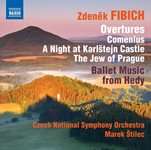|
Back
01/20/2015
“Orchestral Works 4”
Zdeněk Fibich: A Night at Karlstejn Castle Overture – Comenius Festival Overture – The Jew of Prague Tragedy Overture – Ballet Music from “Hedy” opera, Opus 43 – Hippodamia’s Death Melodrama, Opus 33 – Prologue to the Opening of the New Czech Theatre – The Great Musical Monograph of the Building of the National Theatre – Music for the Reopening of the National Theatre – Music for the Celebration of the 300th Anniversary of the Birth of Jan Amos Comenius
Czech National Symphony Orchestra, Marek Stilec (Conductor)
Recording: Czech National Symphony Orchestra Studios, Hostivar, Prague, Czech Republic (October 9 & 29, 2013) – 66’
Naxos # 8.573310 – Booklet in English

   
If the name Zdeněk Fibich doesn’t immediately come to mind, there’s plausible reason. His contemporaries, Bedřich Smetana and Antonín Dvořák, dominated the Bohemian landscape with highly nationalistic purveyances, but Fibich’s musical visions didn’t neatly fold inside this envelope: on balance, he eschewed notions of patriotic flavoring. To the contrary, Fibich’s stylization soaked up international flair, credited with an educational upbringing in France, Germany and Austria. Fibich’s affections drew from literary works such as Byron, Schiller and Shakespeare. Broadly speaking, the music has a certain scale of immensity inscribed in grandiose proportions. Furthermore, the influential structure can be traced back to a great many composers, several which have been cited below. Conductor Marek Stilec masters his quest for Fibich authenticity by painting an effulgent vibrancy inside these shorter orchestral pieces and four tableaux vivants.
A short horn preamble opens A Night at Karlštejn Castle, the first of three “Overtures” commencing this album. This bucolic initiation springs forth moments of Weber and even glances from Norwegian Johann Halvorsen. Characteristic of a symphonic poem, the piece serves up a plate of regal pomp with flourishing tutti chording. The ensuing second theme later melts away the first layer with soothing legatos featuring attenuated likeness to Smetana’s Má vlast (1874-1979.)
Notable 17th century Czech philosopher/theologist, Jan Amos Comenius is the cornerstone for the subsequent musical expedition (as well as the final tableau.) Titled a “Festival Overture”, there’s nothing close to festive in the first half of this composition; however, the waves of foreboding clauses are suddenly parted by clarinet solo that calms the testiness with a sort of Beethovian apotheosis. Fibich liked to revisit his established themes with abbreviation. Tussles of tension are pervasive, striking and arresting. As with many of Fibich’s compositions, the final coda resolves into triumphant stature. The Jew of Prague has a never-ceasing irritability. It is “patent Fibich”, roiling with boiling anger...truly a tragic piece.
Fibich was also prolific in opera though none are performed today (with the exception of a handful staged inside Czech Republic borders.) On this CD we hear the “Concert version” of ballet music from his fourth opera, Hedy (1894-1895), based on Lord Byron’s play Don Juan. Parceled into six segments, the opening movement more closely resembles shadings of his homeland, and Anton Rubinstein’s Feramors (1863) with varying flits of Tchaikovsky. But subsequent sections are clearly apportioned toward influences of Léo Delibes’ Coppélia (1870) and, at times, Adolph Adam’s Si j’étais roi (1852) especially in pizzicati passages. Here, the élan is varied, but Fibich’s music is guided by a lighter, more whimsical beam. The penultimate ¾ waltz session ultimately brings Fibich back to his roots with yearning for a more nationalistic translation. The closing musical argument features lively dumka rhythms…it’s as though we’re listening to dances from The Bartered Bride (1866.)
Richard Wagner certainly wagered heavily into Fibich’s musical equations. A definitive example of this can be found in Hippodamia’s Death with a punch of pomp and circumstance. The piece is redolent with Die Meistersinger (1862) with pronounced triplets in the scoring. The magnificence and mightiness never quits.
Tableaux vivants (“Staged pictures”) was almost a genre-specific identity marker for music that emanated from Central Europe in the 19th century. This idée fixe wrests itself on painting a picture, musically and theatrically, for stage. These full-blown spectacles were in need of reverently captivating music: lavish, majestic and stately on all fronts. Therefore, in the concluding pieces four significant Czech events (the construction, opening and re-opening of the New Czech National Theatre and the 300th Anniversary commemorating Jan Amos Comenius) are clearly represented in a musically magnificent theatrical procession. Fibich’s music is brilliantly splendid and apropos for describing these historical markers, giving truncated likeness to marches found inside Verdi’s Aida (1871) and Don Carlo (1867.)
The Czech National Symphony Orchestra brings Zdeněk Fibich’s music a unique vision. It is captivating and full of energy.
Christie Grimstad
|